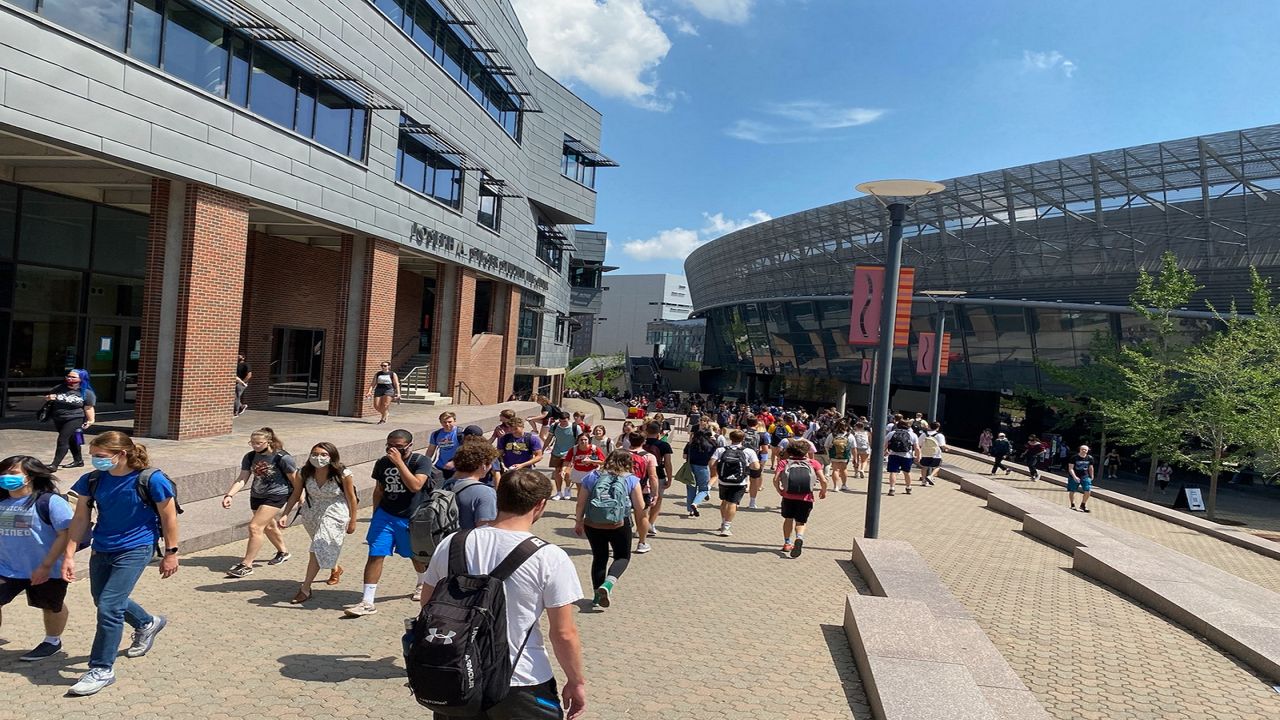CINCINNATI — Garrett Campbell sat at a picnic table tucked out of the way behind the Rhodes Hall, home to many engineering classrooms at the University of Cincinnati.
What You Need To Know
- Greater Cincinnati colleges and universities are returning to in-person instruction this fall
- Schools have various protocols in place to help protect students and staff
- Students who test positive will need to quarantine for seven to 10 days
- Some space will be available on campus, but going home may be a better option for some students
Campbell, 19, was eating lunch in a rare shade-covered spot on UC's main campus while studying for one of his mechanical engineering courses. He made sure to keep his beverage on the other side of the metal table from his expensive graphing calculator and notebook filled with math equations.
"It's great to be on campus again. It's a lot different than last year, way more active," he said. "It feels more like being in college."
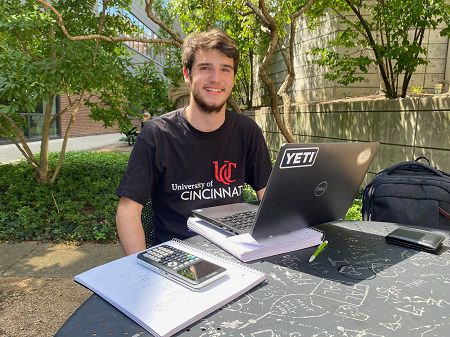
Campbell is one of the thousands of students who returned to college campuses across Greater Cincinnati over the past few weeks. For some, it's their first time being in a classroom, or even on campus, in almost a year.
"I'm not used to having so many people here. It didn’t feel like there were 40,000 people enrolled until the last few days," he added.
The Defiance, Ohio, native spent the first semester of his freshman year living on the Clifton campus, but there weren't as many people there day-to-day due to COVID-19. When classes went remote last spring, Campbell made the decision to move back with his family near Toledo for the remainder of the school year.
Campbell said he thought about moving back for school, but his dad has diabetes and is immunocompromised, so he decided to play it safe.
While he feels he made the right choice, Garrett said remote learning was difficult and his grades "took a bit of a hit."
"(Remote learning) is great for a lot of people, but it didn’t work for me. I felt out of the loop so it didn’t feel like I was actually in classes," he said. "I sometimes had to stop and remind myself, ’This is an actual class. It’s really important. Do better.’”
Recognizing the importance of in-person education, most local college universities have gone back to offering traditional instruction this fall.
Like most institutions, Greater Cincinnati's college and universities have strategies in place to help safeguard students and staff to the best of their ability. That includes requiring masks or face coverings be worn indoors in public areas, including classrooms and student centers.
Some schools, like the University of Dayton, have exceptions for indoor mask-wearing, such as select special events and common areas in residence halls. Though, even in those situations, masks are strongly encouraged.
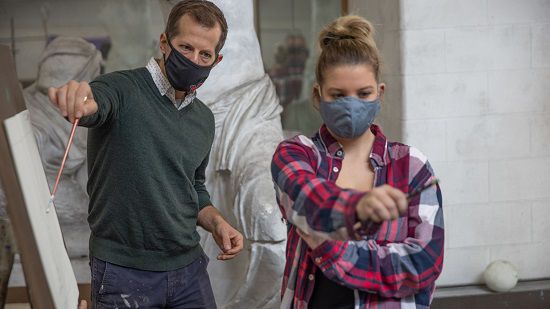
Xavier University and Miami University are two of a handful of Ohio colleges to make receiving a COVID-19 vaccine mandatory for faculty, students and staff.
Jessica Stark Rivinius, director of media relations for Miami, said the requirement will allow for exceptions for medical reasons, religious beliefs and "matters of conscience."
"The Centers for Disease Control and Prevention (CDC) and local, state, and federal public health officials – as well as the public health experts on our campus – believe vaccination is the most important tool for ending the pandemic," she said.
She said more than 75% of its on-campus students have already voluntarily provided proof of vaccination.
Xavier said its student body is at 79% while UD is at 69%.
Stats on UC were not immediately available. Though, UC is holding weekly drawings for cash prizes to help promote vaccination among students and staff. They'll give away $50,000 this fall.
Even with rules and policies in place, odds are some students and staff will contract COVID-19.
In Cincinnati, there have been between 50 and 125 new cases reported every day for the past month, according to the city's health department.
“There are certainly lots of questions from students. The university tries as much as possible to make sure any information and details are out there on our website, but we also have options available to students in person at places like Health Services and my office," said Ron Cushing, director of international services at UC.
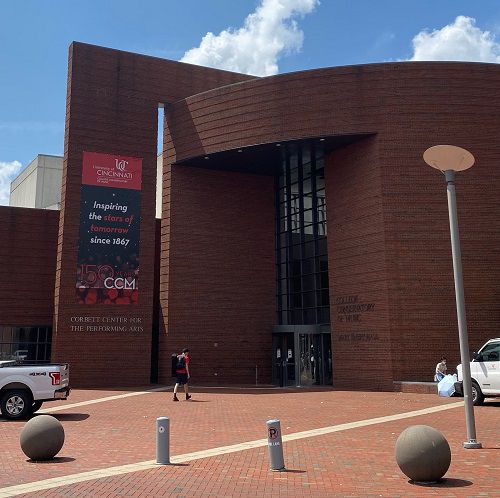
There are about 3,000 international students attending UC. They come from about 100 countries, with the majority hailing from India and China, Cushing said.
A popular question from students is what to do if they've been exposed to or test positive for COVID-19.
“A new student from Columbus, Ohio, isn’t likely to have to quarantine upon arrival to campus. A new student from India, who isn’t fully vaccinated, is going to have to quarantine," he said. "That’s our biggest hurdle — all of our new international students who are not fully vaccinated have to quarantine upon arrival."
Quarantine is something most colleges set up last year to give students a safe space to recover. Schools also offered students educational and other support services.
Usually, isolation is seven to 10 days, but it can be shortened if students have a negative test and are no longer showing symptoms.
As of Tuesday morning, there were 29 UC students either isolating or quarantining, per data from the university.
Whether they're from overseas or from down the street, students residing in campus housing can quarantine in facilities set aside by the university.
Cushing said there are about 7,000 UC students living in campus housing, which includes Campbell. They have fewer than 290 total quarantine and isolation beds available.
"Students who live off campus are expected to quarantine where they are if with family or friends, as long as they’re able to do so safely," he said.
When in-person instruction resumed last year, most schools created quarantine and isolation locations in dormitory buildings and/or off-campus properties to isolate students who had caught COVID-19 or been exposed to it.
That plan continues this year for most schools, though it was a little easier last year due in part to more remote-learning options.
"If they’re residing in our housing, we certainly have quarantine facilities set aside. If a student is in need, we can certainly accommodate that person, in theory, if quarantine housing is not already filled up," Cushing said.
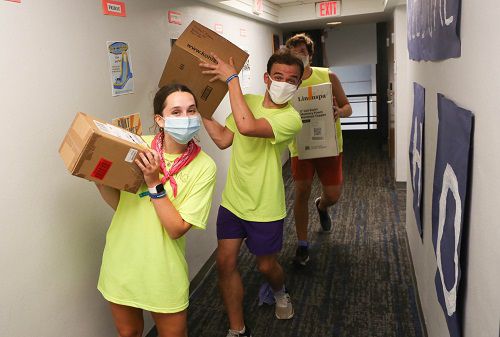
The University of Dayton has an apartment building set aside and additional apartments in another location for isolation and quarantine.
But with the return of in-person challenges, and more students living on campus, space will be at a premium this year, according to Robin Oldenfeld, UD's chief risk officer.
"We have some exceptions that we could consider to let them quarantine on campus, but we’re trying to reserve limited space for those who live beyond a 400-mile radius,” she said.
Oldenfeld said that beyond space considerations, being at home may be in the best interest of the student.
“Isolation can be a challenge. Not just the process of isolation for a positive case, but the actual isolation of being in a room by yourself for seven to 10 days can be very lonely," Oldenfeld said. "So, we really do feel that if it’s better for the individual if they can go home, they should have the support of their family."
Doug Ruschman, with Xavier University, said students who remain on campus during isolation receive regular contact from XU's COVID support team.
"They touch base regularly to make sure everything is going OK. They make sure they have everything: Food, medical attention and anything they may need to stay as healthy and well as possible. That is our goal more than anything else," he said.
Ruschman said students work individually with their respective faculty members to determine what’s best to keep them moving forward with their academic progress. That may mean anything from having a special assignment to remoting into a classroom for a lecture.
"You know, sometimes, when you’re sick, it’s not always the best option to hop on a computer to watch a lecture or to take a test," he said. "Our primary goal is to make sure the student gets well. After that, we will work to make sure the student is able to maintain their academic progress."
Katie Anderson, a sophomore from Zanesville, Ohio, is glad to be back on UC's campus. "It’s almost a little overwhelming, but in a good way," she said.
While Anderson had the option to return home, Anderson made the decision to stay on campus in part due to the fact she had science labs that had to be completed in person. She's a neuropsychology major.
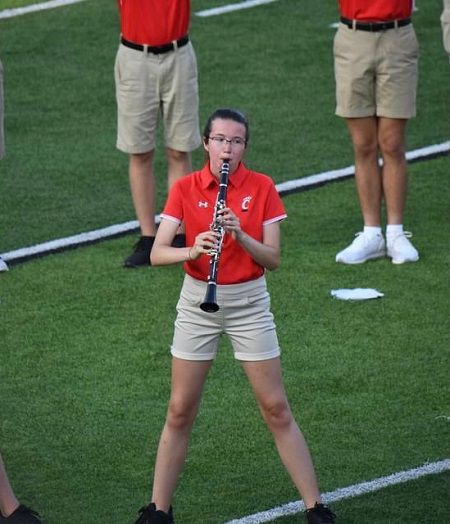
But she also plays the clarinet in UC's marching band and wanted the chance to take part, even if it wasn't exactly the same as usual.
“I am so excited to actually be on the field and marching. Last year was great, but we were only allowed in the stands. Being on the field, being able to march, it's going to be awesome," Anderson said.
Logan Kunk, 19, is in his second year at Miami University. He grew up in Coldwater, Ohio, about 70 miles from Miami’s campus in Oxford. Kunk started out last school year doing remote learning from home, but moved into a campus dorm for the second semester.
He said there are a lot more activities and events already this year. A few of the clubs he's in are much more active, as well.
“It’s been good," he said. "Last year felt very desolate and barren. There wasn’t a whole lot of activity or life going on. You can already see a huge difference."
Kunk lives in a dorm again this year. He shares a room and his building has a communal bathroom. He said there are no specific safety rules for using the bathroom.
"They’ve been strict on masks. It’s still masks on at all times indoors when you’re outside of your specific dorm,” he said. “If you don’t wear your mask, a (resident assistant) will kindly remind you to put one on. They’ve been really good about that."
Beyond the lifestyle improvements, Kunk said living on campus has been beneficial to his education. He's undeclared at this point, but said he's leaning toward majoring in East Asian Cultures with a focus in Japanese.
"Online it is so much harder. In-person is way easier because words aren’t as lost in translation," he said. "Whenever the professor asks you to repeat or say a word or phrase after her, it’s just more synchronized, I suppose."
With the recent uptick in the Delta variant, the threat of schools being shut down or going back to remote learning is definitely a possibility.
"I worry about the band getting shut down, about school getting shut down. But I also think about people, like my dad, who are high risk," Anderson said. "There’s more than just me at risk and it's important we take this seriously."



